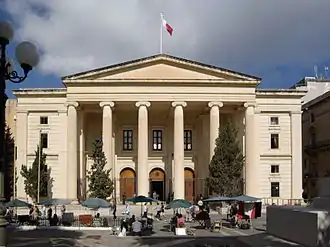| Courts of Justice building | |
|---|---|
 View of the Courts of Justice building | |
| General information | |
| Status | Intact |
| Type | Courthouse |
| Architectural style | Neoclassical |
| Location | Valletta, Malta |
| Coordinates | 35°53′54″N 14°30′44″E / 35.89833°N 14.51222°E |
| Construction started | 5 May 1965 |
| Inaugurated | 9 January 1971 |
| Owner | Government of Malta |
| Technical details | |
| Material | Soft limestone and reinforced concrete[1] |
| Floor count | 7 (4 above street level) |
| Design and construction | |
| Architect(s) | Jo Tonna[1] |
The Courts of Justice building is a courthouse located in Republic Street, Valletta, Malta. It was built in the neoclassical style between 1965 and 1971 on the site of Auberge d'Auvergne, which had been destroyed by aerial bombardment during World War II.
History
The Courts of Justice building stands on the site of Auberge d'Auvergne, a 16th-century building which housed knights of the Order of Saint John from the langue of Auvergne.[1] The auberge was converted into a courthouse in the 19th century,[2] and it remained so until the building was severely damaged when it was hit by a German parachute mine on 30 April 1941, during World War II.[1][3][4]
The law courts moved to another location outside Valletta, but in 1943 they returned to the part of the auberge which was still standing. They remained there until 1956, when the premises had to be vacated due to their dilapidated state. The ruins of the auberge were subsequently demolished, and construction of a new courthouse on the same site began on 5 May 1965.[5][4]
The present courthouse was inaugurated on 9 January 1971 by Prime Minister George Borg Olivier, Governor-General Maurice Henry Dorman, Archbishop Mikiel Gonzi, and a number of judges, magistrates, ministers and other guests. The first case in the new building was held two days later on 11 January 1971.[1][6][4]
The courthouse also houses the Civil Courts Registry, the Court Archives, the police lock-up and a car park. The Valletta Police Station was formerly also housed within the building.[6][7]
The courthouse has been criticized, in the past, for its lack of security and for having the elevators out of order.[8]
Some buildings, opposite the Law Courts building on Strait Street, are an extension of the courts.[9]
Architecture
The Courts of Justice building is built to the designs of architect Jo Tonna in the neoclassical style, and its main feature is a portico with six columns.[1] The building has seven floors, three of which are below the main front street level.[6][1] The building occupies an entire block of the city,[9] except one corner which is occupied by the Savoy Building.
References
- 1 2 3 4 5 6 7 "Replacement and Restoration of the Portico Column Bases at the Courts of Justice, Valletta" (PDF). Ministry for Justice, Culture and Local Government. 2012. p. 59 (2). Archived from the original (PDF) on 24 December 2016.
- ↑ Cauchi, Jacqueline Azzopardi; Knepper, Paul (1 February 2009). "The Empire, the police, and the introduction of fingerprint technology in Malta". Criminology & Criminal Justice. London: Sage. 9 (1): 78. CiteSeerX 10.1.1.896.3771. doi:10.1177/1748895808099181. ISSN 1748-8958. OCLC 746934116. S2CID 146525063.
- ↑ Denaro, Victor F. (1959). "Houses in Kingsway and Old Bakery Street, Valletta" (PDF). Melita Historica. Malta Historical Society. 2 (4): 204. Archived from the original (PDF) on 9 May 2016.
- 1 2 3 Guillaumier, Alfie (2005). Bliet u Rħula Maltin (in Maltese). Santa Venera: Klabb Kotba Maltin. pp. 922–923. ISBN 99932-39-40-2.
- ↑ Ganado, Albert (28 March 1966). "Law Courts in Valletta". Times of Malta. pp. 39–40.
- 1 2 3 "The Courts". The Judiciary of Malta. Archived from the original on 6 January 2015.
- ↑ DeBono, Daniela (2013). "'Less than human': the detention of irregular immigrants in Malta" (PDF). Race & Class. Institute of Race Relations. 55 (2): 60-81. doi:10.1177/0306396813497880. S2CID 143536044.
- ↑ "California Law Business". Los Angeles Daily Journal. Daily Journal Corporation: 259. 2001. ISSN 0362-5575. OCLC 17960662.
- 1 2 Bianco, Lino (2009). "Valletta: A city in history" (PDF). Melita Theologica. University of Malta: Department of Architecture and Urban Design - Faculty for the Built Environment. 60 (2): 3–20. ISSN 1012-9588. OCLC 1587122. Archived from the original (PDF) on 19 March 2018.
